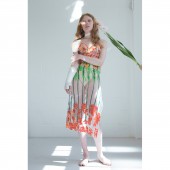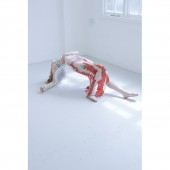
| THE AWARD |
| CATEGORIES |
| REGISTRATION |
| SUBMIT YOUR WORK |
| ENTRY INSTRUCTIONS |
| TERMS & CONDITIONS |
| PUBLICATIONS |
| DATES & FEES |
| METHODOLOGY |
| CONTACT |
| WINNERS |
| PRESS ROOM |
| GET INVOLVED |
| DESIGN PRIZE |
| DESIGN STORE |
| THE AWARD | JURY | CATEGORIES | REGISTRATION | PRESS | WINNERS | PUBLICATIONS | ENTRY INSTRUCTIONS |
The Withering Flower Printed Textile by Tsai Jung Chiang |
Home > Winners > Design #95294 >Interview |
 |
|
FS: What is the main principle, idea and inspiration behind your design?
AC: The inspiration of The Withering Flower collection initially came from studying one of the Chinese' four great literature classics, "The Dream of the Red Chamber" by Cao Xueqin in the 18th century. Throughout the story, images of flowers are spontaneously written as personification and foreshadowing as each character progressed over the storyline. One of the poems that appeared in the story, "The song of the Flower Burial," as sung by the female protagonist, is a metaphor to the character's silent struggles in a feudal and aristocratic society. The image of a flower's decay and burial symbolizes the inevitable death of all beautiful things, and the poem has since become my core inspiration to further study the flower image and its significance in Chinese culture.
FS: What has been your main focus in designing this work? Especially what did you want to achieve?
AC: There are two core focuses in this collection: the conceptual research on the flower's image correlates with cultural identity and the technical execution on developing the textile technique. For the conceptual aspect, I hope to discover the flower image beyond its traditional association with prettiness and affinity by examing the withered flower's symbolism, and the reason of why the decay is often perceived as misfortune in Chinese literature and culture. For the technical aspect, I aimed to develop a specific silkscreen printing technique, that would make prints stay securely opaque on mesh and net fabrics while retaining the fabric's elasticity.
FS: What are your future plans for this award winning design?
AC: I plan to continue further study on the flower's significance in Chinese literature and create a visual library of the flower images' meanings and unique application throughout historical and contemporary cultural settings. Alongside the continuous conceptual research, I also plan on working larger scale art pieces and installations with the textile applique for a future solo exhibition.
FS: How long did it take you to design this particular concept?
AC: The whole process, from the research phase to the finalized pieces, took approximately three to four months to complete.
FS: Why did you design this particular concept? Was this design commissioned or did you decide to pursuit an inspiration?
AC: The collection is designed and made for the graduate fashion show during my BA studies at Central Saint Martins College of Art and Design.
FS: Is your design being produced or used by another company, or do you plan to sell or lease the production rights or do you intent to produce your work yourself?
AC: The design is currently not for sale; it is used by Angela Tsai Jung Chiang's studio for future artwork development.
FS: What made you design this particular type of work?
AC: During my BA at Central Saint Martins College of Art and Design, my studies specialized in womenswear and printed textile design. As my childhood aspiration was to become a manga artist, I have always think of the prints on clothes as bringing essence out of a 2D paper, like painting on a living canvas. When I was working on this collection, I precisely wanted to infuse the 2D perspective into the dresses, creating a linear and flat silhouette as though every piece of dress could roll into a scroll, and layout open like a painting. The use of this particular textile technique, printing opaquely onto see-through fabrics, created an illusion of the prints floating in the air, and the method links back to my core vision of bringing essence out of 2D paper.
FS: Where there any other designs and/or designers that helped the influence the design of your work?
AC: During the conceptual research phase, I found great inspiration from the Chinese literature classic "The Dream of the Red Chamber" by Cao Xueqin in the 18th century. I was also greatly inspired by British Artist, Anya Gallaccio. Gallaccio's site-specific installations using organic and decomposable matters have been a fascinating inspiration for me to further look into the transience of life.
FS: Who is the target customer for his design?
AC: This collection of printed dresses is created as art pieces, more of an artistic approach. However, the prints in this collection would improvise into a visual library, with each flower image/print correlating to its symbolism in Chinese literature in the future.
FS: What sets this design apart from other similar or resembling concepts?
AC: Each choice of floral print in the collection is based on its unique cultural language and symbolism in Chinese culture and heritage. One of the dresses in the collection is printed in chrysanthemum motifs, the cultural language associated with chrysanthemums are the flowers for the funeral, as it is a taboo of gifting chrysanthemum in Chinese culture. Another dress from the collection is printed in decayed poppies. The poppy flower itself is considered as a controversial symbol, and the use of decaying matters as adornment on the body is sought to be bringing bad luck from cultural myths. In the context of this collection, I want to question what shapes the viewer and the community's validation of what is considered as a sublime and objection.
FS: How did you come up with the name for this design? What does it mean?
AC: In contrast to the blooming flower's popularity, the decaying flower is often associated with jinx and taboos in Chinese culture. The withering flower is perceived as abject and to be consciously avoided in a broad cultural context, from principles in Fengshui to gifting etiquette in Chinese culture. The portrayal of the flower image would link to the sentiments and glorification on preserving life, sustaining good fortunes, while subconsciously evading symbols of passing and downfall. The name of the collection, The Withering Flower, is also a question about what is considered as abject, and what is impacting the conventional perceptiveness.
FS: Which design tools did you use when you were working on this project?
AC: The design began with live drawing and observation on both the blooming and the withering flowers over two weeks. I used pencil, felted pen, ink, and charcoal to capture the silhouette of the flower's life cycle, from the freshly blooming flowers to its gradual decay. The hand illustrations were transformed onto silkscreens for textile printing, and lastly, the fabrics were sewn into dress pieces.
FS: How did you decide to submit your design to an international design competition?
AC: The Withering Flower collection was nominated to apply for the A'Design Award. It is a fantastic experience to take part in the international design competition.
FS: Thank you for providing us with this opportunity to interview you.
A' Design Award and Competitions grants rights to press members and bloggers to use parts of this interview. This interview is provided as it is; DesignPRWire and A' Design Award and Competitions cannot be held responsible for the answers given by participating designers.
| SOCIAL |
| + Add to Likes / Favorites | Send to My Email | Comment | View Press-Release | Translations |





